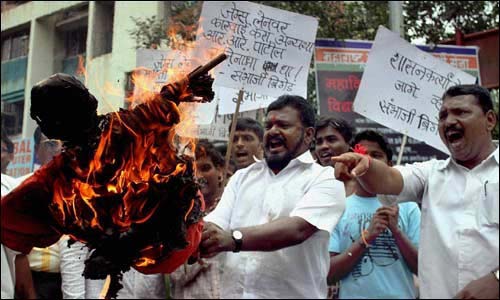BANNING HISTORY
Bookshops are afraid to stock James Laine’s `Shivaji: Hindu King in Islamic India’, even after the Supreme Court struck down the Maharashtra government’s ban on it. Jyoti Punwani speaks to filmmaker Anand Patwardhan, one of three petitioners who challenged the ban.
What prompted you to challenge the ban on James Laine’s book?
 Dr. Ambedkar gave us our Constitution. It is up to us to protect its spirit. Whether it is Ambedkar’s “Riddles in Hinduism” or works by Taslima Nasreen, we must not allow bullies to dictate what we read. I would oppose a ban even on books I abhor, like those by Golwalkar and Godse. The real inspiration and the legal hard work however came from a civil liberties and human rights lawyer friend, P.A. Sebastian. We have won many court battles against the censorship of my documentary films. In each case the courts, including the Supreme Court, upheld my right to freedom of expression and the public’s right to information. Naturally when we heard about a book being banned under pressure from right wing groups, we intervened. Though I had not read the book at the time, the principle was important.
Dr. Ambedkar gave us our Constitution. It is up to us to protect its spirit. Whether it is Ambedkar’s “Riddles in Hinduism” or works by Taslima Nasreen, we must not allow bullies to dictate what we read. I would oppose a ban even on books I abhor, like those by Golwalkar and Godse. The real inspiration and the legal hard work however came from a civil liberties and human rights lawyer friend, P.A. Sebastian. We have won many court battles against the censorship of my documentary films. In each case the courts, including the Supreme Court, upheld my right to freedom of expression and the public’s right to information. Naturally when we heard about a book being banned under pressure from right wing groups, we intervened. Though I had not read the book at the time, the principle was important.
Those opposing the judgment have made it a Maratha Vs Brahmin issue?
No one reads the book so the entire opposition to it is based on hearsay. Incidentally all the petitioners come from different castes, dalit, maratha, brahmin, though each of us categorically rejects the caste system. In fact the claim that Laine’s book is a “Brahmin”
conspiracy against the “Maratha” Shivaji is so hollow, it could not be articulated even by those who fought for a ban in court. They could only argue that it would cause enmity between those who admire Shivaji and those who don’t. When the court asked “Who does not admire Shivaji?” there was no answer.
The attempt to reduce Shivaji’s greatness to his paternity reveals a desire for sacrosanct bloodlines (Vaunsha and Kula). The very concept of “purity” comes from patriarchal upper castes that had to establish their long lineage to mythical forefathers. So some Marathas proudly claim “Shahannau Kula” (96 forefathers) and some Brahmins maintain immaculate family trees. Laine himself has no caste axe to grind. He compares texts written in Shivaji’s lifetime where the brahmin Ramdas is hardly mentioned, with those written in the brahminical Peshwa period where Ramdas gains prominence as Shivaji’s guru, to texts inspired by the Varkari movement, those written by Mahatma Phule, by the British, each with their distinct motivations. He paints a complex picture of 17th century Maharashtra where cross-religious alliances were the norm.
Shivaji has been created over time as a symbol of Hindu manhood fighting against the evil Muslim empire. The reality was more fluid. Shivaji’s father served the Nizam Shah and then the Adil Shahi sultanate in the South, his mother Jijau’s father aligned with Nizam Shah and later with Mughals, Shivaji himself at one point joined Aurangzeb’s son Muazzam’s forces against common enemies and so on. This complexity is anathema to those who want to use Shivaji as a symbol of Hindutva or who appropriate him as a caste hero. This is not only an injustice to Shivaji, but also to historical and scientific enquiry. Laine’s anatomy of a legend is not the last word on Shivaji. Nor must it be a word that is forbidden